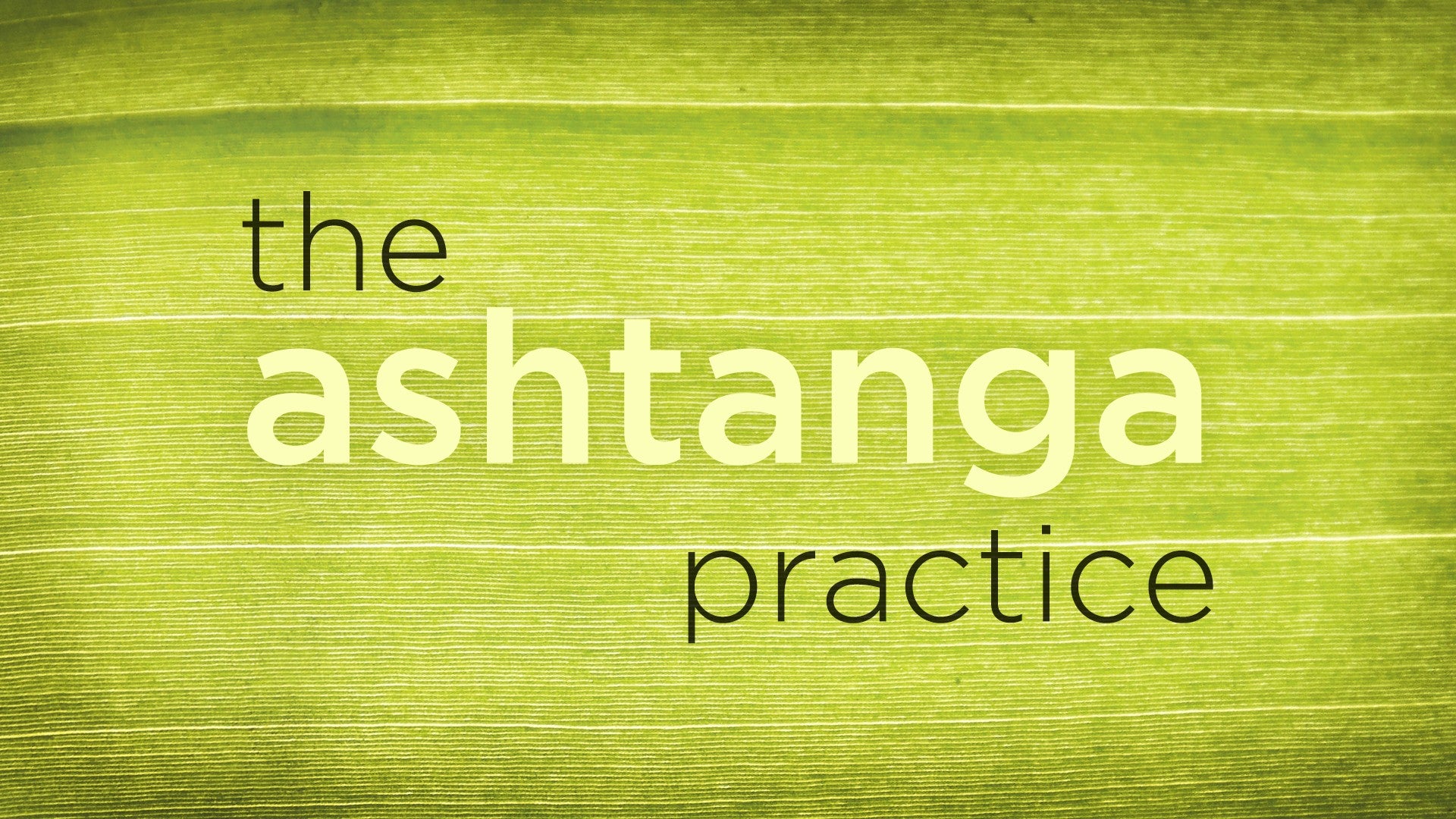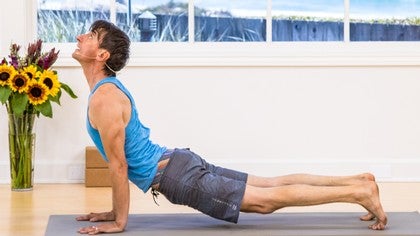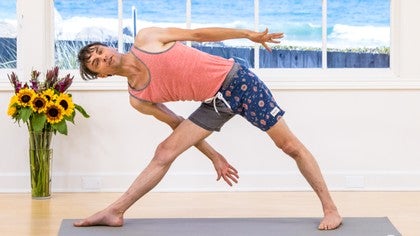Description
About This Video
Transcript
Read Full Transcript
(waves crashing) Welcome to session two. Today we're continuing our focus on surya namaskara. So yesterday we worked with positions one through four, or zero through four. And kinda took a break there. So we didn't get all the way into fourth.
But we will continue today. We're working to get through the nine positions and their transitions. All right, so stand with me. You're in samasthiti. And remember that curiosity and research, exploration is a big part of what you're up to.
So you're simply standing and turning your attention to that active standing. And I can give you so many ideas about it. But you've got to come up with your own ideas and get very interested in it, passionate about, wow, what are the meditative possibilities of standing? So there's an absorption in that process. And so you stamp down into the earth through the feet.
Remember, that's an active stamping. Here we go, lift your right foot and whack the earth. And left, and you like that percussive feeling. Tooch, tooch, and it's rhythmic. Okay, and then when you're standing it has that feeling of life, of wow! I'm calling to the earth and feeling the earth's response, which is the earth, and it flows up through the legs.
And helps to support your position and stabilize you. Okay, and so the pelvis is neutral. Remember, we worked with tipping it forward. Try it, tip your pelvis forward with an exaggerated move. And then backwards, tuck it under, like an ashamed dog.
And then neutral. What is neutral? And partly one image to get neutral is that imagine that you're coccyx, you have a vestige of a tail, right at the end of your spine. You imagine that's a real tail like a monkey or a panther, and it dangles down all the way to the ground between your feet. And that panther tail weights the back of the pelvis.
And then you lift up the navel in front. And that will you give you a nice feeling for power in your center. Okay, then you lift up the chest, roll back the heads of the arms until they're in the side plane. Reach down through the pinky fingers and enjoy the zero position, gazing far away at the horizon. The steady gaze.
So the theme today is the second limb. It's called positive action, niyama. Okay, and so all of what I just instructed is what I mean by positive action. It's like you take charge of your standing, you take charge of your breathing, you take charge of the way your mind is working and your perceptions. So that is yoga.
And now we'll work with kind of loop, reviewing first, second and third position in the transitions. So here we are at zero. Spin the arms in external rotation. Make the palms face away from each other. Draw the breath in, reach up with a radiance, (inhales) spreading your wings, stamp the hands together, look up past the thumbs.
Enjoy that destination momentarily. Then, wow! Project the spine forward, strengthen the legs and come down into second position. Stop the body. And then third position, remember, lift up the spine, lift up the head, go way up on your fingertips so you can get the shoulder loop and ground the legs. Then, again, fold into second position with a move.
(exhales) And inhale, come all the way up to first position. Keep that position momentarily and drop your gaze. Look down your body. So reach up through the hands and lift the upper chest, release your floating ribs downwards, lift the navel, imagine that long tail to get a neutral pelvis, ground your thighs, so make your legs very firm and stamp the feet. Okay, then, look forward and swim the arms to samasthiti.
And, again, reach out to the sides, breathe in. (inhales) Stamp the hands together overhead or keep the arms apart and work. Then project the spine out. (exhales) Feel the groundedness of the legs, come into second position. Contemplate that destination as you arrive and stay momentarily.
Then inhale. (inhales) The in-breath creates a gesture that lifts the chest, lifts the navel, stop there and enjoy. And then exhale. (exhale) And inhale come up, reaching. Synchronizing the movement with the breath, reach out to the sides, returning to samasthiti.
And, again, (inhales) reach and then project the spine away as you come into your forward bend, keeping your weight shifted forward, all the way 'til the heels almost lift up. So it's a little dicey. Then, inhale, third position. The arms and legs are long. The spine elongates horizontally, the shoulders loop back, look up between the eyebrows, steadily, and fold again.
(exhales) If the legs are bending, look for a sec. So, remember, if you're bending your knees, they're going towards straight. So that's a big difference between bending and straightening. So you're straightening even if they don't get straight. And that's how you'll get your leg, this fiber tissues to elongate over time.
Come back up. (inhales) So you're slenderizing your body along that central axis. And try to sense it. So part of your research, your exploration, is to feel the arrangement of your skeleton, looking forward. And then actually look at me.
Stay in your position, though, arms up. See that joint arrangement? Wrist, elbow, shoulder, look at the ribs, even though they're not joints. (laughs) Keep those aligned. Pelvis, knees, so look at some examples. Here, what if I was like this?
That's not a vertical arrangement. Or what if I was reaching up like this? That's not a vertical arrangement. So it takes some real thinking. What is actually neutral?
And what clarifies that vertical axis? That's your study. And this unfolds over long time, long time, not two months, not two years, not 20 years, maybe 120 years. (laughs) Now we're gonna continue our exploration of fourth position and pick up where we left off at plank. So here we go, come down onto all fours. And, remember, plant the hands, and you want your weight shifted forward.
Okay? So straighten the right leg, straighten the left, stay forward, and enjoy. So you're pressing the hands down, lengthening the arm bones, and lifting up into your upper back. You firming the thighs, firming the belly. Come down for a minute.
And so remember we were talking about the pelvic tilt. So there's this slightest backward tilt you're working with here, just a littlest hint. So it's no forward, you don't want forward. And the belly, so the belly has to do what we call uddiyana bandha, it has to fly up and it has to get firm. So there's a kinda firming of the belly that happens there that supports the position.
All right, and so that slight lengthening of the tail come into plank, and actually just tone your abdomen, grab on there. And tone your buttocks. And grab the thighs. So there's real work happening in your center to support that position. Okay, come down.
Now the tricky part. Okay, so that's plank, that's one possible destination. But there's a further destination, we call it chaturanga dandasana, the four limb staff. 'Kay, I'm gonna show it to you and then we'll look at options for how to get it going. So from plank you go (exhales), it's like a push up.
You come down and hover just off the ground with poise. Okay? And so that is not easy to do. All right, and remember the idea of the staff, the rod. So you don't want the parts of the body coming down at different times like this.
See, watch. Things like this'll happen. All these different configurations that you don't want. And so that's why we start with the plank. So you get that nice long line and then you preserve it.
Okay, here's just a couple of ways to think about preserving it that make it easier. One is to think that the only change that needs to happen is a hinging at the elbow. There's no other change, it's simply bend that elbow and do it fast before your mind has time to think, and start going, wait a minute, do I tuck my tail? Or what do I do with my belly? You just wanna forget all that kind of reasoning and make it happen.
So here we go, you're in plank. Keep your weight forward. And then all of a sudden, whook! Come down and bend. Notice how fast that was. That is key.
Here, look at this. Not like this. (grunts) Okay? And also it comes all the way to its destination in one move. So you know where you're going.
Come to plank, try it with me. And whoo! Come down and stop. So if you make it dynamic, come back up to plank. And, again, come down and stop. By bringing that sense of urgency to it.
Whook! You stand a good chance of like getting your whole body to respond to it. But you may not be able to do that no matter what your best try. So here's a few things you can do. Remember, you're personalizing your destination. So you can bend the elbows only this much.
And feel where the integrity begins to lapse. So you want integrity. So maybe your position will be like this. (exhales) Do it with me, even if you can go lower, go to plank. And here we go.
(exhales) Just bend a tiny bit, keep your weight forward and hold. See, that's the key. So, remember, not to discount your personalized destination. So wherever that is is rad, that's how you wanna see it. And that's where you build power.
So when you come down this far, get into that position and feel it, get passionate about that. And that's just so cool anyway, but that's your best chance of getting strength and progressing to another stage. Even though you don't have to. Every stage is worthy of meditation if it's done nicely, okay? And that's where we run into problems is we think that the stage is ahead is better and we're willing to compromise the skeletal positioning or our thinking, or breathing.
So you want to be very clear that your personal destination, done with integrity, is your aim. Okay, so here we are in plank. Come down just a little bit. (exhales) And create a lined position, strengthen the arms and legs, strengthen the belly, the buttocks, look either down, slightly forward, or way forward. And hold that position.
So that's where the discipline comes. And that is the positive action. That's the second limb of yoga, where you do what you can, you take the positive step that you can, which is completely different than either not even ever trying, or kinda accenting the negative. So now another possibility. So from plank, it's easier if you bend your knees.
Just take the knees to the ground. And it's a tiny bit awkward, but it takes a lot of weight off the upper body. And then (exhales) you can come down. So what? You do your chaturanga with your knees on the ground.
Try it out with me. So take plank, put your knees on the ground, tuck your tail, keep your weight forward, stamp the ground and swiftly bend and come down into position. Okay, some of you won't be able to lower that low yet. No problem, stop in the middle with your knees down. So whatever...
You have to contemplate, you're thinking about, you're researching and then getting feedback from your body. What is my head doing in relation to my torso? In relation to my pelvis? Okay, in this position, the staff, chaturanga dandasana. Okay, so there you go, you've got some options.
And that means every time you pass through this position, you can make use of them. So you can go here, or you can take your knees down. Or come wherever is suitable to you. And now we'll look at the transition. This is one of the most awesome transitions in the practice.
It's the one where you go from third position to fourth position. So we're gonna take it in stages, come up to third position, and then there's a setup position, I call it the crouch. You're on your fingertips, you've lifted your chest, your whole body is exposed forward, right? And then from there, you drive the knees forward. See, do this move with me.
You actually drive forward and go into a kind of almost like a skiers position. And, look, my heels are up. So get up, get there with me. So your heels are lifted, you're bent into a crouch, you're looking forward. Okay, so that is your setup position, right there.
Your tips of the fingers are down, the heels are up, your body weight is forward, lean forward, whoa, almost tipping. Okay. So that's the crouch. Everybody can do it. And then what would happen next is variable, depending, you have to personalize the destination.
So here's the easiest. Okay, so from this crouch, let's get to this position, and then, look, you simply step the right leg back, step the left back, come into plank. And proceed from there. Let's do it. So come into that third position, bend your knees.
Lift the chest up and then step the right, step the left, keep your weight forward. And enjoy that plank. So the next move would be to jump to plank. So I go come back up with me. We'll get into third position, then bend the knees into that crouch, get ready, and jump to plank.
Come down for a sec, and notice the economy of that. So it's not like this. So I come, I bend, I don't go like this. (laughs) All right? So you want, look at this, this chest is in a perfect position to going to plank.
So alls I do is bend my knees, get ready, and shoot the hips and legs back. And I stabilize my body on landing so it doesn't give. It gives slightly. It's not a rigid landing, but it's also quite steady. Okay?
And then from there, gets more challenging. (laughs) So from there you bend the elbows on the way. And, ideally, what you're trying to do is bend your elbows like that chaturanga move that we worked on, going from plank, shoot the hips and legs back, but you want your upper body in position before your lower body hits. That's tricky. And I'll show you how to do it, and then I'll show you the example in case you're like, "What? "I don't know what he means by that." Okay, so here it is.
I get into third position, I crouch, and then, whoa. Such a dynamic move to come to the destination. And, remember, you always wanna come to your destination and stop. Okay? So here's what I mean by if I jump and then lower.
So you might have a habit of doing this, and it might be too hard to do the other thing I'm telling you, but you're working towards it. So I'm showing you. Here you go. You crouch, get ready, and then you spring, and finish coming down after you land. 'Kay, so you can do that, but you're working to get your upper body into position and then the feet come down.
So we'll do it a few times. And, remember, every option has value. Even if you crouch and step, that's amazing, and go ahead and use it. And get into it, get passionate about your personal move. So here we go, from third position, drive the legs into a crouch, get ready and spring.
Come down and stop at the destination and enjoy. We'll try it again, step forward, third position. Lift up the chest, then crouch and keep your upper body forward as you shoot the hips and legs back. Come down and stop and hover. Last time, come third position.
Crouch, spring, and one Mississippi, two Mississippi, three Mississippi, you hold that chaturanga. And you'll develop strength. Okay, one last note about this particularly challenging asana, is that remember that positive action. Baby steps, every little positive effort you make each day, each practice, counts. That's what adds up to give you a yoga practice, to give you that soulful thing that you can center yourself in.
All right, so now we'll look at fifth position. In looking at fifth position, what I want you to do is come down onto your belly. And plant your feet, and feel your belly down. Feel the pubic bone down, the belly down, and then lift up your chest. So you're gonna place your arms kinda like in a chaturanga position, right below the shoulders.
And roll back the shoulders. Push down through the hand and then lift up the spine. Okay, so it's kind of a move where you stamp the earth with the hands. Lift up the spine and kind of suck the spine into the body. Look at me for a sec.
You're trying to get the spine, the upper spine in particularly, to bow into the body as you reach back through the legs. Okay, so here we go. Plant the feet, firm the thighs, plant the hands, roll back the shoulders and lift up the spine. Try to curve it into the body and lift up the navel. And kinda let it come down a tiny bit and then again.
Strike the earth with the hands, lift the spine. And so you kind of, the hands are supporting, but you're trying to lift the spine up independently and get it to disappear from the back to the front to broaden the chest. Okay. So it's kind of serpent-like, like a snake. So the snake is connected to the earth.
And he's defensive, he lifts up away from the earth. Kind of lifts up, rears up. And then try that. So lift up the spine and curve it into the body. Plant your legs, stabilize your pelvis, and enjoy.
Okay, so take a little moment. And it's this action want you to see, that (exhales) spine kind of gets lifted up and sucked into the body. That is your move that you're working on. It's very dynamic move. Okay, so we'll take it a little bit further by straightening the arms about halfway.
So you are up about, come up, so here's down. Kind of lift away from the earth. Reach back through the legs and roll the shoulders back and then project the spine into the body. So you're trying to puff the chest as you reach back through the legs. Come down and go back up.
Stamp the ground, lift the spine up, reach back through the legs. And come down. Okay, so there's a feeling of coming from the ground up. So we're kind of emerging from the earth and lifting the spine away from the earth. So for the upward dog, you actually straighten the arms and you get the vertical shoulder, elbow, wrist and you lift the thighs off the ground.
So it's only your hands and feet in touch with the earth. And the legs are heavy. The pelvis is heavy. So it kinda drops down towards the earth and yet the thighs get firm and that kind of lifts the legs. Okay, and then the same thing.
Stamp the hands down, lengthen the arms and lift up the chest. So for the moment you're looking forward. And staying. Come down for a sec. That's some work.
And you want to work to center your spine right between the arm foundation. All right, and here I'm gonna give you an example of forward. So if you get your position, your shoulders are forward, look at my shoulders in relation to my wrist. It's so hard to get any bend. But then also, if you're back, look at my shoulders in relation to my wrists.
This is very stressful on the lower spine. So you want to get the most benefit from your foundation, center yourself right in the middle. So, come on, experiment with me here. Come up into your upward dog, here we go. And then walk your feet forward.
Feel it, get way out there, you can't get any good feeling of a arch in your back. And then go way back. And way back. It can be good (laughs) actually, in this funny kind of way. But not over a long term.
So you can feel how it compresses the lower back and the go find that center place, where the skeleton really supports your spinal position. And notice the work, whoo! So the transition from fourth to fifth position is a tricky one. So I'm gonna give you several options so you can sort something out for yourself. So the easiest way I know how to do it is no matter what your version of fourth position, say it's plank, or down partway, or all the way, is that you cheat, you take your belly to the ground, point your toes, and come up. (laughs) Okay, let's do that.
So it's very simple, actually, you're in chaturanga. Just take your belly to the ground, point your toes, and then build your upward dog from the ground up. You can feel the foundation. It's very simple transition. Another way you can do it as an exercise, it's just mostly for kind of understanding.
And it's challenging, 'cause you can feel what the move is. So the move is simply to straighten the arms. There's no shoulder work needed. So people often mistake that in this transition. They think you have to shrug the shoulders back.
But the chaturanga, our shoulder position and the upward dog shoulder position are the same. So you don't have to do anything but straighten your arms. And to do that, we'll practice this. So I'll show you once. You come down in your chaturanga and then you leave your legs the same.
Just straighten the arms. And that's all. It's really a very economical and easy thing to do. So, come on, let's try it. Get into plank, come down to chaturanga, then keep your legs exactly like they are and straighten your arms, project your spine forward.
And you can do it with one of three head positions. You can look forward, you can kinda scan down, or you can look up. Okay, let's try it. Plank, chaturanga, and then do it come up looking forward. 'Kay, and then back plank, chaturanga and try it looking up.
So look up and back. And feel how much work it takes in the arms to do it that economically. And then the tricky part comes in trying to roll over the tops of the feet. 'Cause what happens is if you're a little bit tighter and you directly roll over the tops of the feet, you'll end up too far forward in your position. So look at what I'm talking about.
So I come down to Chaturanga and then when I just go, see, look how I end up. That's a very common mistake or problem that happens. So the solution is to do the cheat that I showed you. Just come down and point the toes in advance. Or you make strategy where you push back through your feet.
That's the tricky part is you push back through the feet as you straighten your arms. And that solves the problem. Okay, so watch me. I come down, chaturanga. And then look at that, I'm pushing back through my feet.
And then I straighten the arms. And I come up in a nice position. Let's try it. It does require some strength to be able to do it, so it may take practice. So here we go.
Down to chaturanga, then start to push back through the feet and then straighten the arms and make the legs very stubborn and heavy. Again, plank, chaturanga, push back through the feet and straighten the arms. And notice the spinal position that you come to in relation to your arm foundation. So you don't wanna be forward or behind of that and you want your strategy to make sure that you get the proper position. So let me just review those options with you.
So can come all the way down to your belly and just point the toes and come up into position. Or you can (laughs), one other cheat, I didn't tell you, is you could do one foot at a time, and then come up. Let's try that one. Come part the way down, place one foot, place the other, and come into your position. Okay, so it gets tricky when you try to do it dynamically.
But that's kinda the coolest move, too. So it's worth taking the time to try to learn it by pushing back through the feet strongly as you straighten the arms. Okay, so now we'll look at sixth position briefly. And so here we go. You've got your hands at the front of the mat, shoulder width apart, stamp the hands down, walk your feet back to the back of the mat, so you're not in the all fours kinda thing, because you've got your arms sloping on a diagonal.
Then tip the pelvis forward and keep it tipped forward. So you've got the buttocks blooming, but suck the front ribs up. And then from there, lift the hips. And I walked my feet in a little bit so you gotta kinda find the right distance. And so you've got your pelvis tipped fowrard.
So the pubic bone is going back between the legs. But the ribs are sucked up towards the spine. And you are working with samasthiti, that very first work we've been doing from the pelvis. Look to the side and look at me. So we've this whole line, this hip, the ribs, the shoulder, the elbow, the wrist, all in one continuous line as you work.
And watch, I'll give you an example of not that. So look at this, here the shoulders are giving way, the ribs have given way. Or here, my back is rounded. So you've got to find the middle. So if you took a rest to look at all that then come back into it.
And here we go. Plant the hands. Your hands actually stamp the earth and it's kind of an up and over feeling, almost like a mad pianist. So look at this. So the arm comes up over the top and strikes, over the top and strikes the earth.
And then the thighs press back, so it's kinda like being on the rack. But it's a benevolent rack, it's kind of a voluntary elongation of the spine, using your arms and legs, and steadying your breath. (inhaling and exhaling) So this is your first inversion, so you can feel immediately how it relaxes the brain. The belly goes free almost without any effort on your part. Long breath, long limbs, long spine.
Okay, then the next move. That completes, we've covered all the positions, because seven, eight and nine are reviews of one, two and three. So let's look at this crouch. So I bend the knees, I bring my thighs forward and I get into an animal-ready crouch. So we're gonna do that together.
Come into your downward dog. And then notice, I don't go, this isn't my crouch. Look at that, so you've got my pelvis tip forward, and I'm not bent much, but this isn't my crouch, either, way down here, like into a total squat. I'm right in the middle. And look at this lightening strike leg position, the thigh, versus the shin.
You get into a animal-ready crouch, and then we'll do this exercise where you fake spring. You go crouch and whoo! Throw your weight forward without actually jumping. And, again, dynamic throw forward, go into your crouch, get ready. Dynamically. So look at this end point, I shifted my weight forward.
So from there you do the spring. And I'll show you the spring and then I'll show you some options. So we go into the crouch and then like that's a coiling of a spring, and then wow! That energy gets released in a leap forward. And if you can't do that, you can crouch and step. Look at this.
Crouch and then build energy, and then whoo, step. And come to that seventh position, which is just third position all over again. Or you can jump a little ways. So you crouch and jump and then finish it off. All the options are good.
Let's do it a few times. And you can choose yours. You can step, you can hop part of the way and then walk, or you can work on the full spring. Here we go, crouch, spring. So you're trying to land lightly, your feet right between the hands, then jump to downward dog.
And, again, crouch, spring. Lift up the chest, come into seventh position. And notice it's exactly the position we already worked on before. And jump to downward dog. And crouch.
Spring. So you gotta practice that move and come to the destination of seventh position each time. Back to downward dog, crouch, spring, lift up the chest upon landing. And come to the end point. That's with a breath in.
One last time, jump to downward dog, crouch and spring. Lift up the chest, and we've got seventh position. Then there's a fold again. (exhales) Eighth position. Stop at the end point.
So, remember, from seventh to eighth position, keep your weight forward. Make a dynamic move. See, watch. (exhales) Come to an end point and stop. Try it again, breathe in, look up.
And with a move, exhale. Plant the feet and hands, shift your weight forward, bring your forehead towards your shins. To emphasize that dynamic part, I want you to try this. You've come to the end point of seventh position. And then when you go for the move, Lift up the arms and shift your weight forward, whoa, almost to the heels lifting up.
Try it again. Lift the chest, lift the sitting bones, ground the legs. And get ready, then (exhales) lift up the arms behind you and, wow! So it's like launching. Plant the feet and thighs, elongate the spine. That's an eighth position.
Okay, here we go. This time, don't lift up the arms, we get that feeling of grounded legs, the spine elongating downwards. Here we go, seventh position, then exhale, fold. Stop. And come up, reaching over head.
Stop at at the destination in ninth position, turn the palms out and return to samasthiti. So we'll do one surya namaskara together, in all of its glory, putting together all the elements. So you're in the zero position. Strike the earth with the feet, firm the legs, lift the navel. Lift the chest.
Enjoy, neutral, with an empty mind. Internalize senses, then spin the arms in external rotation. (inhales) Reach up to first position. Come to the destination as you fill up your lungs. Exhale forward.
Come to the end point of second position and stop, enjoying that momentarily. Then lift the chest head, ground the thighs, shift your weight forward, get ready. Use your option, jump. And come to our personal destination of fourth position, and stop hovering in place and enjoying. Then roll over the tops of the feet, lift up the chest as you plant the hands.
Look up and over with a steady gaze. Pull the hips back smoothly into sixth position. Stamp the hands down. (exhales) Press the thigh bones back. So you've got the pelvis tipped forward, sending the public bone back and back, and back.
You keep the ribs sucked up and the spine dips down from the base through the crown of the head, dips down towards the mat as you strengthen your arms and legs. Okay, then go into a crouch as you empty the lungs. And spring. Plant your feet, lengthen your leg bones, lift up the chest, look up between the eyebrows, keep your weight forward. Empty the lungs.
(exhales) With a steam pressing sound, come into eighth position. Inhale, reach, come to the destination and stop. Drop your gaze, drop your head. Scan down the body, plant the thighs, lift up the naval. And swim the arms down to return to zero.
Okay, so there you have it, the second session. So just wanna remind you that that theme of positive action, the second limb of yoga, so that all this work that we're doing is you kind of training your mind what to focus on, so it's very positive things. This is how you reach up, this is how you go into fourth position, et cetera. These things are positive actions that you're taking. They're kind of intermediary steps towards coming into a state of yoga, which is an empty state, a completely receptive state.
So you're kind of dropping those positive actions eventually, but you have to make liberal use of those to get a grip on what yoga is about. Okay, so I look forward to joining you tomorrow. Namaste.
The Ashtanga Practice: David Garrigues
Comments
You need to be a subscriber to post a comment.
Please Log In or Create an Account to start your free trial.

















